
All smartmicro intersection sensors use multi-object, multilane tracking technology and provide lane specific advance detection, allowing users to implement adaptive control strategies or green light extension for intersections with one single radar per approach, even on curved approaches.
The company offers wide beam sensor models which can cover up to six lanes of traffic, or narrow beam models for detection ranges of up to 305 metres.
The NEMA compliant sensors are typically installed on a pole at the roadside or overhead and are easy to integrate with existing infrastructure such as street lights or traffic signals. smartmicro claims the sensors function robustly under even the most adverse weather conditions and deliver the highest detection rates with a very low number of false calls.









